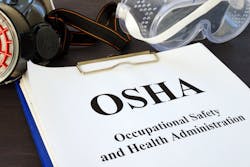OSHA Revises Beryllium Standard for Clarification
Three years after OSHA's 2017 publication of Occupational Exposure to Beryllium and Beryllium Compounds, the agency has revised the standard once again.
Changes to the standard in the latest final rule aim to "clarify, simplify or improve compliance" while maintaining safety for general industry workers.
Multiple sections of the standard were amended including verbage throughout “Definitions,” “Methods of Compliance,” “Personal Protective Clothing and Equipment,” “Hygiene Areas and Practices,” “Housekeeping,” “Medical Surveillance,” “Hazard Communication” and “Recordkeeping.”
The new rule also added its first addendum: Appendix A: “Operations for Establishing Beryllium Work Areas.”
According to the executive summary, changes to the standard are detailed in Section XI, Summary and Explanation of the Final Rule. The summary also states:
Broadly, OSHA proposed to add one definition and modify five existing terms in paragraph (b), Definitions; to amend paragraph (f), Methods of compliance; paragraph (h), Personal protective clothing and equipment; paragraph (i), Hygiene areas and practices; paragraph (j), Housekeeping; paragraph (k), Medical surveillance; paragraph (m), Communication of hazards; and paragraph (n), Recordkeeping; and to replace the 2017 final standard’s Appendix A with a new appendix designed to supplement the proposed definition of beryllium work area.
OSHA is finalizing these provisions as proposed, with the following exceptions. First, OSHA is revising the definition of confirmed positive to state that the findings of two abnormal, one abnormal and one borderline, or three borderline results need to occur from beryllium lymphocyte proliferation tests (BeLPTs) conducted within a three-year period. This differs from the definition proposed in the 2018 NPRM, which would have required that any combination of test results specified in the definition must be obtained within the 30-day follow-up test period required after a first abnormal or borderline BeLPT test result. Second, OSHA is modifying the proposed paragraph (j)(3), which requires employers to take certain actions when transferring materials that contain at least 0.1 percent beryllium by weight or that are contaminated with beryllium outside a plant for the purpose of disposal, recycling, or reuse, to clarify that only transfers outside of a plant, including between facilities owned by the same employer, are subject to the labeling requirements of paragraph (m)(3). Third, in paragraphs (k)(2)(iii) and (iv), OSHA is modifying the proposed provisions pertaining to an employer’s obligation to offer a medical examination after an employee is exposed to beryllium in an emergency. Fourth, OSHA is amending proposed paragraph (k)(7)(i) to require that an examination at a chronic beryllium disease (CBD) diagnostic center be scheduled within 30 days of the employer receiving certain types of documentation, listed in paragraph (k)(7)(i)(A) and (B), that trigger evaluation for CBD.
OSHA is further revising proposed paragraph (k)(7) by adding a new provision,
paragraph (k)(7)(ii), which clarifies that, as part of the evaluation at the CBD diagnostic center, the employer must ensure that the employee is offered any tests deemed appropriate by the examining physician at the CBD diagnostic center and to state that if any tests deemed appropriate by the physician are not available at the CBD diagnostic center, they may be performed at another location that is mutually agreed upon by the employer and the employee. For a full explanation of comments received and OSHA’s reasoning for these revisions, see Section XI, Summary and Explanation of the Final Rule.
The agency also revised the compliance date of the final standard to September 14, 2020.
OSHA has been enforcing most of the provisions for general industry since Dec. 12, 2018. The agency began enforcing the provisions for change rooms and showers on March 11, 2019, and engineering controls on March 10, 2020. The final standard will affect approximately 50,500 workers employed in general industry and is estimated to yield minor net cost savings to employers.
About the Author
EHS Today Staff
EHS Today's editorial staff includes:
Dave Blanchard, Editor-in-Chief: During his career Dave has led the editorial management of many of Endeavor Business Media's best-known brands, including IndustryWeek, EHS Today, Material Handling & Logistics, Logistics Today, Supply Chain Technology News, and Business Finance. In addition, he serves as senior content director of the annual Safety Leadership Conference. With over 30 years of B2B media experience, Dave literally wrote the book on supply chain management, Supply Chain Management Best Practices (John Wiley & Sons, 2021), which has been translated into several languages and is currently in its third edition. He is a frequent speaker and moderator at major trade shows and conferences, and has won numerous awards for writing and editing. He is a voting member of the jury of the Logistics Hall of Fame, and is a graduate of Northern Illinois University.
Adrienne Selko, Senior Editor: In addition to her roles with EHS Today and the Safety Leadership Conference, Adrienne is also a senior editor at IndustryWeek and has written about many topics, with her current focus on workforce development strategies. She is also a senior editor at Material Handling & Logistics. Previously she was in corporate communications at a medical manufacturing company as well as a large regional bank. She is the author of Do I Have to Wear Garlic Around My Neck?, which made the Cleveland Plain Dealer's best sellers list.
Nicole Stempak, Managing Editor: Nicole Stempak is managing editor of EHS Today and conference content manager of the Safety Leadership Conference.
